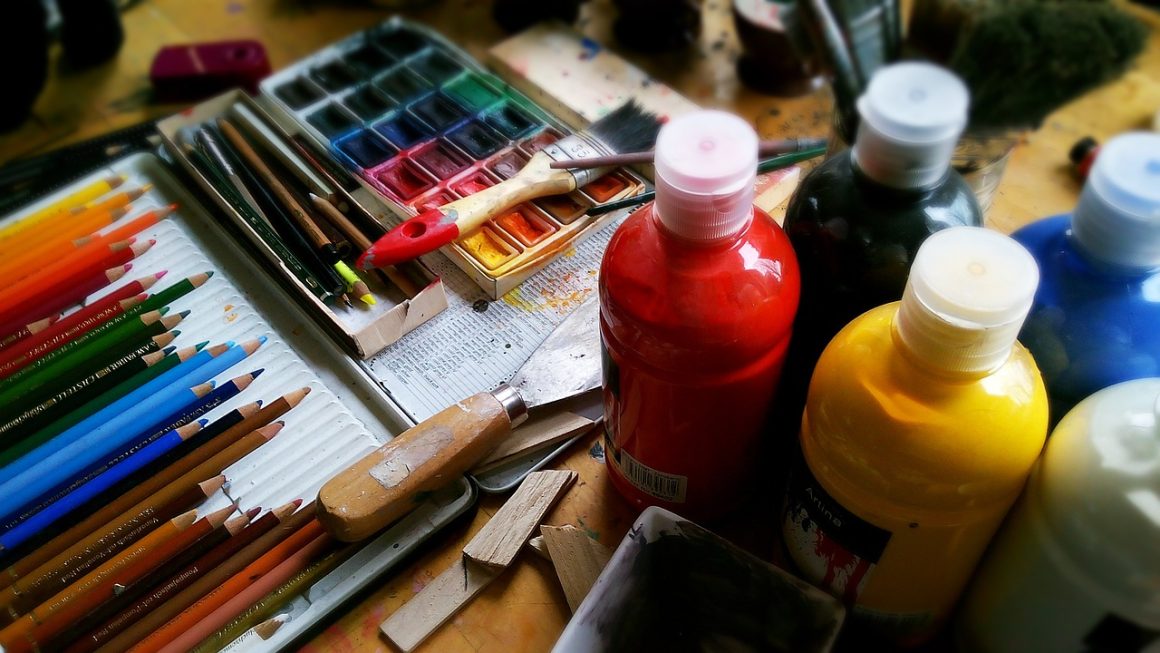Painting glass is not only a popular hobby but also a calling for many professional artists.
The better the quality of the paint that you use for these projects, the better the results are. Of course, the trouble is that there are so many choices out there. How do you know which is best?
We rolled up our sleeves and got to work, testing dozens of options before choosing the absolute best.
Let’s kick things off with our top choices for the paints for glass. Each one of these selections is easy to use, effective, and affordable.
Best Paints for Glass:
1. Apple Barrel PROMOABI Acrylic Paint Set
If you’re looking for paints to use on glass, then you can’t go wrong with this selection. These paints work equally as well on Styrofoam, terra cotta, wood, plaster, and tin.
With easy flow and great coverage, these matte acrylic paints dry with surprising speed. Cleanup is a snap. All you need is soap and water, so spills are never a concern.
This set comes in 18 colors, and each bottle contains two ounces of paint.
The colors included range from black to white with hues like New Shamrock, Bright Magenta, Jack-o-Lantern, Pewter Grey, Nutmeg Brown, and others in between.
All the paints in this set are water-based and non-toxic. Made in the USA, you can trust this product from Plaid, which is a well-known name in the craft industry.
Apple Barrel is a reliable line of acrylic paints that dry quickly and look great.
These creamy paints glide onto the glass like a dream. Most people remark that this set is a smart and economical choice, though some wish the hues had better opacity.
Pros
- Great selection of colors
- Plenty of paint in two-ounce bottles
- A creamy paint that glides well on any surface
Cons
- May not be opaque enough for some projects
2. Zenacolor Acrylic Paint
While these deserve to be listed among the paints for painting glass, it’s worth noting that each tube includes just 0.4 ounces, or 12 milliliters, of paint.
If you are a heavy user, this may not be the most economical choice.
Nonetheless, this is a high-quality set of non-toxic acrylic paints. Because they are water-based, they are safe to use and easy to wash away from clothing or skin.
Because this set contains 24 colors, it comes with nearly everything that the glass artist needs.
Each hue is vivid and bright, and the collection includes popular colors like titanium white, viridian green, vermilion red, and lamp black.
One thing that makes these paints a great choice is how easily they can be mixed. If you’re ready to create colors, this is a magnificent place to start. You also might appreciate the 30-day warranty that assures a complete refund if you’re not satisfied.
Any artist who is excited about learning to mix paint with ease will love this set.
Fans of this set love the colors and how they flow across any surface, but some people were disappointed that the packaging was torn upon receipt.
Pros
- Bright, vibrant colors
- Great for mixing
- Excellent selection of hues
Cons
- Small tubes
- Packaging sometimes fails
3. FolkArt Gloss Finish Acrylic Enamel Craft
Dedicated glass artists will appreciate that this paint is specially formulated for their use. What’s more, FolkArt is one of the most recognizable and dependable of all paint brands for crafts.
This means that you’ll probably love this selection.
Glass painting is an art, and a painting has to possess certain qualities to achieve the right effects. Once applied to a glass object, the paint can be cured by baking. This makes the object dishwasher-safe on the top shelf.
With a scratch-resistant, durable, and glossy finish, these paints look gorgeous on glass. A high degree of pigmentation ensures opaque coverage in each of the 16 colors, which include white, black, and every color in between.
Specially formulated for use on glass, these FolkArt paints are a tried-and-true selection.
Calling them fun and magical, many glass artists are in love with these paintings. They appreciate the subtle sparkle that each hue brings to the glass.
Nonetheless, it’s important to remember to be patient. Curing for 21 days before the use of painted objects is recommended.
Pros
- Subtle sparkle
- Designed for use on glass
- Excellent opacity
Cons
- Not for the impatient
4. Magicdo Stained Glass Paint with Palette
Artists who love the look of stained glass will be excited to try this stained glass paint. An acrylic enamel, this paint allows you to make your own stained glass.
Put this acrylic paint on glass, and you’re certain to end up with a memorable result. This set includes 12 colors such as Titanium White, Black, Violet, Rose, Burnt Umber, and more.
These 12-milliliter bottles are small, but a little goes a long way. Plus, the price is right. A set that this affordable is easy to replace when certain colors get low.
These paints are non-toxic and free of odors and solvents. With spectacular adhesion abilities and water resistance, these are a great choice for long-lasting finished products. Baking painted glassware ensures a tough, durable finish.
Anyone who has ever dreamed of creating stained glass has a chance with this paint. Artists love the beauty of these colors, remarking that they blend with incredible ease. Many users say that these paints can turn any piece of glass into stained glass.
It’s important to realize before purchasing that this is a translucent paint. If you want better opacity, stick to a more traditional acrylic.
Pros
- Gorgeous colors
- Easy flow
- Makes any glass look like stained glass
Cons
- May be too translucent for some projects
5. Arteza Fabric Paint for Textiles, Canvas, and Wood
When you’re looking for paint to use on glass, fabric paint may not immediately spring to mind. However, this excellent 3D paint works just as well on glass, ceramic, and plastic.
Each one-ounce tube is filled with puffy paint that can be conveniently squeezed onto the work surface. The pen-shaped bottles are equipped with fine tips, but this set also includes a variety of other tips for creating thicker lines or multiple lines at once.
Because they are easy to hold and dispense paint easily, these fabric paints are incredibly popular. The 30 colors include predictable basics like Titanium White, Yellow Ochre, and Space Black as well as several metallic shades.
Artists will appreciate the inclusion of a variety of fluorescent hues, glitter paint, and glow-in-the-dark paint.
People who have tried these paints love how easy they are to use. Also of note is how durable these paints are. After several years, they look just as good. Nonetheless, users do remark that getting the hang of using the squeeze tube can take time.
Pros
- So many colors!
- A wide variety of tips
- Fun and easy-to-make intricate designs
Cons
- Using the squeeze tube requires practice
Factors to Consider
Type of Paint Works Best on Glass
The first thing to consider when choosing the right paint is to identify what type of paint works best on glass. Generally, there are three options from which to choose.
These include acrylic enamel and other acrylics that are specially formulated for use on glass or a solvent paint that is designed to be used on glass.
Usually, it is the acrylic enamels and acrylic paints for glass that are most commonly used by crafters and hobbyists. Enamel paints promise great versatility, but you may need to prime the glass before you paint it.
These paints also tend to be oil-based, which means that they can be both toxic and flammable. You can find water-based enamel paints that do away with these disadvantages.
Acrylic paints are enormously popular for use on glass. They dry fast and are water-based for a non-toxic experience that’s safe for anyone. When using acrylics, it’s wise to remember that they often look darker when dry than they do when wet, which can affect the look of the finished project.
Opaque or Transparent Finish
When choosing the paint that works on glass, you may want to weigh several factors.
One of these is whether you hope to achieve an opaque or transparent finish.
If you’re looking for lovely, light transparency, then one of the stained glass options presented above is right for you.
However, if you’re looking for the brightest, most vibrant colors, then you want to paint that dials up the opacity.
Textures and Dimensions
Another factor to think about is whether you want your paint to add dimension to the finished piece. The puffy fabric paint that is described above is ideal for blending in different textures and dimensions.
FAQ
How do you prepare glass for painting?
No matter what type of paint you decide to use, it won’t adhere to the surface unless that surface is perfectly clean. Ordinary soap and water are all that’s necessary for squeaky clean glass, though some people do prefer to use rubbing alcohol to be certain the glass is clean. Once it’s dry, the glass is ready for painting.
How do you know what type of paint to use on glass?
You can choose from a range of acrylics and enamel acrylics, all of which are available in water-based, non-toxic formulas. Ideally, you’ll choose a product that is labeled specifically for use on glass for the best results.
Before making a purchase, consider how opaque or transparent the paint needs to be. This will largely determine which paint is right for your project.
How long does it take paint to dry on glass?
This will vary depending on which paint you choose. Carefully read the instructions on the label to see what the manufacturer recommends. It is not unusual to see dry times of between one and three hours. Following this guideline in between coats is recommended.
Once the appropriate level of brightness or opacity is achieved, it makes sense to allow the finished project to dry for between a week and 21 days for curing.
Is it safe to put painted glass in the dishwasher?
Some painted glass objects are intended to only be seen while others are meant to be used. If your finished project will need regular cleaning, then it’s wise to look for paint that can be baked on to ensure a durable finish.
Paints that are compatible with dishwasher cleaning say so right on the label, and they contain specific instructions for preparation.
Making the Decision
After our painstaking review, we believe that the paint for glass is the FolkArt Enamel Glass Painting Set. This specially formulated paint provides bright, opaque colors with remarkably easy flow. We love the glossy, durable finish and how well this paint resists scratching.
If you’re looking for something less opaque, then go with the Magicdo Stained Glass Paint set. Non-toxic and odor-free, these paints provide you with the beautiful look of stained glass at a reasonable price


